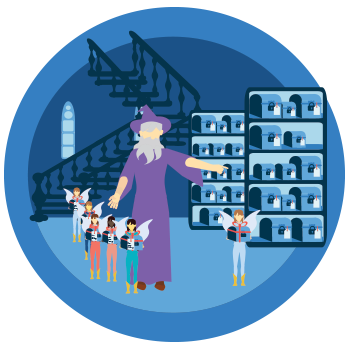The tale
The data chests brought back by the elves came in all different sizes, shapes and packaging. Some were even locked in chains with a padlock. Luckily, the elves were able to buy a key for them. Others were nicely wrapped with curled ribbons and small tags, saying things like ‘For you to keep’, and even marked with small drawings to help the elves where they could not read the local tongue. One elf named Ruby came back with a trembling data chest.
– “What’s wrong with this one?” Ruby asked the wizard. “It is wrapped like the others, but there is no tag on it. Have I done something wrong?”
– “Oh, let me see”, said the wizard. “It looks exactly like what we need, but we have to throw it in the moat. We do not know if it is bewitched. And we can’t use it without knowing whether we are allowed to use it or not.”
– “What!” exclaimed Ruby in disbelief. “Can’t you do something? If this is what we need, why can’t we keep it?”
– “I know, I know”, said the wizard. “Although it looks like a gift, we can’t keep it, because it doesn’t carry the gift tag. But this is not your fault Ruby”, the wizard said padding Ruby on the head.
The truth
Licensing data and metadata is an important aspect of the FAIR principles; both if you retain some or all rights, or if you set your data free as completely open data. In a FAIR context, a license is a standardised machine-readable statement that tells the end user exactly how he or she can use the data, and under which conditions.
You can apply many different licenses to data. One of the most common is the Creative Commons license suite, where you explicitly state how and if you are to be cited when your data are reused, along with possible re-sharing options of derived works etc. Typically, you choose a license when depositing data in a repository. You do not have to apply the same license to all your data, and stating full copyright is a license in itself. The worst thing you can do is not to apply any license at all. Because then your data is most likely protected by copyright as default, even though the data are publicly accessible.
If you use other people’s data, you should always identify the conditions of how and when you can use the data. This may affect the way you can work with their data.

